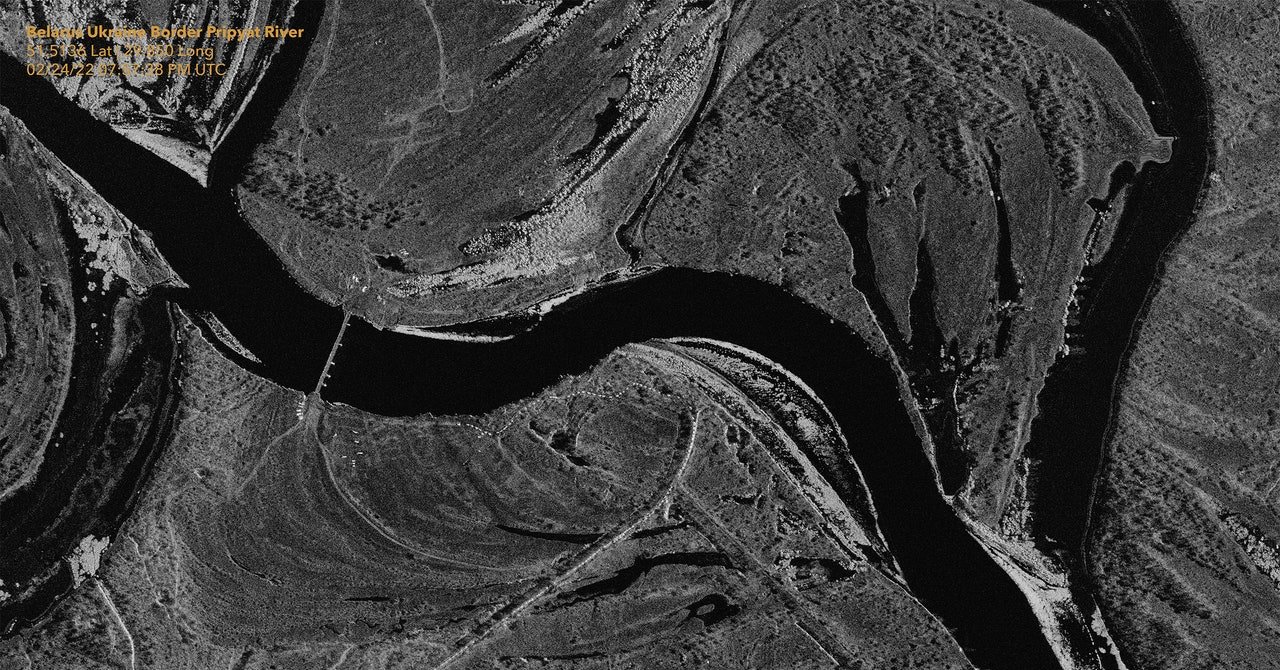The traffic jam stretched from the Russian city of Belgorod to the Ukrainian border. Google Maps marked the congestion with red and orange, just as it does in all countries where the app is used to track traffic. But the GPS satellites sending these vehicles’ positions to Google were not picking up an ordinary traffic jam. This was 40 kilometers of traffic caused by Russian troops.
That convoy turned out to be an early warning that the Russian troops amassed on Ukraine’s borders were on the move. It was first noticed at 3:15 am on Thursday of last week by Jeffrey Lewis, a professor at the Middlebury Institute of International Studies (MIIS), a graduate school in California—hours before reports of Ukraine’s first explosions filtered into the news. But he did not stumble on it by accident. Lewis had a tip-off from a radar image taken by a commercial satellite company called Capella Space, which showed Russian troops lined up along the road in columns near Belgorod. “When the Russians are camping for a long time they park their tanks in a square and they put up tents,” says Lewis.
But this satellite image showed troops in a very different formation. There were no tents; they were ready to move. When one of Lewis’ colleagues started searching for the routes this column might take to move toward Ukraine, he found the traffic jam. “It’s really a story about fusing different kinds of data,” says Lewis.
Then, on February 28, Google said it would temporarily turn off live traffic updates in Ukraine “after consulting with multiple sources on the ground, including local authorities.” Google did not elaborate on why it was worried about the feature. But researchers speculate the company is concerned that traffic data revealing the location of troops or refugees could be used to inform military strikes. “You can understand why Google would not want to be a party to providing targeting data in an international conflict,” says Lewis.
In the sky above Ukraine right now are around 50 working satellites, estimates Todd Humphreys, a professor at the University of Texas. Those satellites have become a key part of Ukraine’s efforts to fend off a Russian invasion. The government there has been pleading for satellite images for clues of where Russian troops might move next.
US authorities gave Ukrainian president Volodymyr Zelensky a satellite phone so they could stay in touch, according to CNN. And Ukraine is also flying drones made by a Turkish company, Bayraktar, which allows some of its models to be controlled remotely via satellite link. But the reliance on commercial satellites in Ukraine is raising concerns about the power they give to the companies that control them, and also the risk of satellite companies being dragged into the conflict.
This is not the “world’s first satellite war.” That title was given to the Gulf War, three decades ago. Since then, space has become a normal part of modern conflict, says Almudena Azcárate Ortega, associate researcher at the United Nations Institute for Disarmament Research (UNIDIR). “In recent years, there’s been a tendency to outsource a lot of this work due to the fact that private companies have specialized knowledge and they are often better able to develop and deploy certain types of space of technology,” says Ortega, adding that many space objects are now called “dual-use.” “That means that one satellite can be used at the same time for military purposes, but also for civilian everyday things,” she says.
At this time of year, Ukraine’s skies are carpeted with clouds. Companies are now in high demand if they can produce a type of data called radar, which works at night and can see through clouds. Radar images are generated by Synthetic Aperture Radar (SAR) satellites, which map the world in a way that’s similar to how bats navigate in the dark—by sending out radio waves and measuring how their signals are reflected back. To carry out their work, open source researchers like Lewis buy radar data from companies like Capella and Planet, both based in San Francisco. They also have to pay for a software, such as ENVI, to interpret that radar data and turn it into images. His team’s ability to use this software is a result of years of training, he adds. “Three years ago we would not have been able to do this.”
Open source researchers are not the only ones demanding this data. Militaries want it too. “We badly need the opportunity to watch the movement of Russian troops, especially at night when our technologies are blind,” Ukraine’s vice prime minister Mykhailo Fedorov said on March 1. In a letter posted on Twitter, Fedorov called on eight commercial satellite companies to send SAR satellite data to help Ukraine’s Armed Forces see Russian troop movements through clouds. One of the companies to respond was Capella. Its founder and CEO, Payam Banazadeh, says the company is providing satellite imagery of Ukraine to both the Ukrainian and US governments.


Leave a Reply
You must be logged in to post a comment.